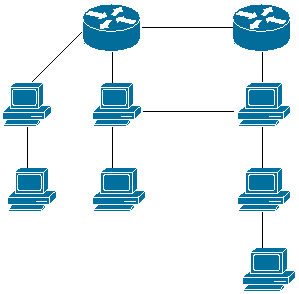Reading
Autonomous System
Cisco BGP Overview
BGP RFC
(Skim only!)
Tasks
This lab is focused on configuring and managing routes between
administrative domains (also referred to as Autonomous Systems or AS's).
The protocol that is used for inter-domain routing is the Border Gateway
Protocol (BGP). The version of BGP that is currently used in the Internet
is v4. Every AS/network that is connected to the Internet must have a node
(router) that participates in BGP (a BGP speaker). These nodes announce
which networks (IP address ranges specified using the CIDR "slash
notation") are contained within or can be accessed through an AS, and
likewise use the information transmitted by other BGP speakers to determine
how to send packets to destination networks. For example, the BGP speaker
at UW-Madison would announce to the other BGP speakers it is connected to
(via BGP sessions) the IP address ranges for the active networks on the
UW-Madison campus. If UW-Madison only had a single upstream provider
through which it gained access to the rest of the Internet (and therefore
only a single BGP session), it would be referred to as a "stub network".
Since UW-Madison has multiple upstream providers (and therefore multiple
BGP session), it is referred to as a "multi-homed network". A third
category is "transit networks". These are networks that are not only the
sources/destinations of traffic, but also connectivity between networks.
Transit networks are typically larger Internet Service Providers that
maintain many BGP sessions with their customers (i.e., the networks who pay
them for upstream connectivity) and their peers (i.e., the other large
networks that they connect to but neither pays the other).
You will gain experience with inter-domain router configuration and
management by conducting several different experiments. Note that
configuration and management of inter-domain routes actually has two
components: the first are the activities external to a network (covered by
EGRP or Exterior Gateway Routing Protocol) and the second are the activities
internal to a network (covered by IGRP or Interior Gateway Routing
Protocol). All of the inter-domain information is transmitted via EGRP,
while the directives about external networks to the intra-domain
infrastructures within an AS are transmitted via IGRP. There are many
references available on the web and in textbooks for BGP, EGRP and IGRP.
As mentioned earlier, inter-domain routes in BGP are established by passing
path vectors between networks. In addition to networks, attributes and
local preferences are transmitted. Ideally, this local preference
information is meant to help establish effective routes, but the lack of
standards and the need for flexibility actually complicate this process
significantly.
You will begin lab #5 by learning how to configure an end host to behave
like a BGP router. While this can be useful by itself (e.g., end hosts are
sometimes used for certain BGP measurement related functions), it is
particularly important in the WAIL environment to enable studies of larger
groups of BGP speakers. There are several different share-ware routing
packages that include BGP capability. The package we will use in this lab
is called Quagga.
You will also conduct a set of experiments on system configurations in WAIL
that include Cisco IP routers that have BGP capability. Like lab #4, you
will use Cisco Internetwork Operating System (IOS and its command line
interface (CLI) to configure and assess the BGP routes that are established
in this lab.
Tools
In addition to the recommended readings above, you will need to familiarize
yourself with the Quagga soft-router that is available in Linux and
other platforms. Information can be found at:
Quagga BGP
module
An important capability in BGP is to limit or filter the information that is
propagated. This is especially important for large service providers who
periodically receive erroneous updates from their customers that might
cause large traffic swings in the network (so called black holes).
Information on route filtering can be found at:
ip
as-path access-list
Finally, a list of the IOS commands for configuring BGP on Cisco routers
can be found at:
route-map
Topology
You will build a network that has the following topology for this lab:

The NS file for this topology can be found at:
NS file or Routerless NS file
Questions
Please enter the answers to these questions into your lab notebooks before you
start the lab.
1. What is path vector routing and why is it used in BGP?
2. Compare path vectors to distance vectors
in terms of efficiency and functionality.
3. How does Local and Transit traffic differ?
4. What is path exploration in BGP?
5. What is a BGP speaker? How do they relate to an AS?
What types of information do they exchange?
6. Give a reason why a non-symmetric route between two nodes might
be desired.
|